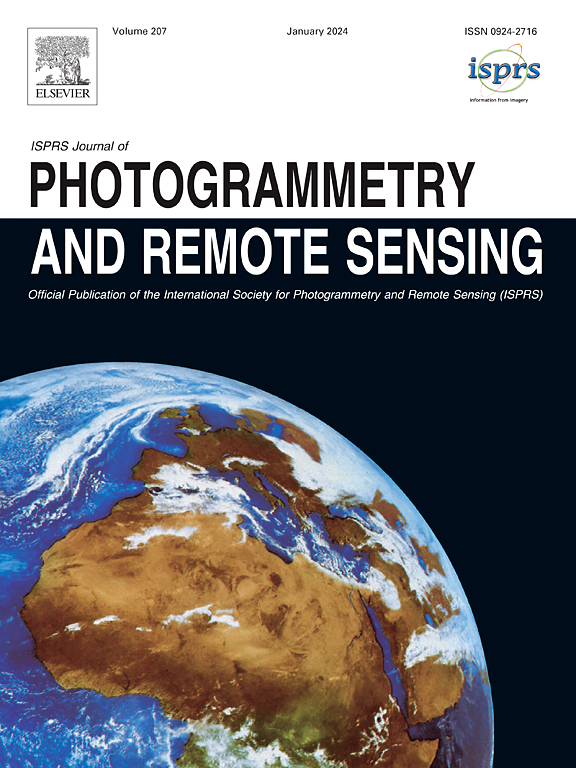Automated registration of forest point clouds from terrestrial and drone platforms using structural features
IF 10.6
1区 地球科学
Q1 GEOGRAPHY, PHYSICAL
ISPRS Journal of Photogrammetry and Remote Sensing
Pub Date : 2025-03-12
DOI:10.1016/j.isprsjprs.2025.02.023
引用次数: 0
Abstract
Light Detection and Ranging (LiDAR) technology has demonstrated significant effectiveness in forest remote sensing. Terrestrial Laser Scanning (TLS) and Drone Laser Scanning (DLS) systems reconstruct forest point clouds from distinct perspectives. However, a single-platform point cloud is insufficient for a comprehensive reconstruction of multi-layered forest structures. Therefore, registration of point clouds from multiple platforms is an important procedure for providing comprehensive three dimensional reconstruction of the trees for more accurate characterization in forest inventories. However, the irregular and intricate structures of forest scenes, which often lack easily recognizable geometric features such as lines and planes, present substantial challenges for existing registration algorithms, such as Coherent Point Drift(CPD), Fast Global Registration(FGR), and Four Points Congruent Sets(4PCS). To address these challenges, we develop a novel algorithm, namely ForAlign, for the registration of forest point clouds from TLS and DLS. Our algorithm incorporates a tree location-based matching procedure followed by dynamic programming for detailed alignment. It fully considers the issue of inconsistent point cloud density distributions from different platforms and utilizes differential entropy to identify subsets of points with consistent structural features from the two data sources. These subsets serve as the basis for point cloud alignment based on distribution information. To validate the generality and accuracy of the proposed ForAlign, we conducted experiments using both scanned and simulated data describing different forest environments. The results show that our method achieves superior performance, with an average translation error of 6.4 cm and a rotation error of 53.5 mrad, outperforming CPD, FGR, and 4PCS by 43.5%, 55.4%, and 44.0% in translation accuracy, and by 36.4%, 54.6%, and 42.4% in rotation accuracy, respectively. Our study demonstrates that ForAlign effectively mitigates the errors introduced by tree localization in the preprocessing steps caused by varying point densities in TLS and DLS datasets, successfully extracts corresponding tree features among complicated forest scenes, and enables a robust, automated end-to-end registration process. The source code of ForAlign and the dataset are available at https://github.com/yiliutan/ForAlign.

使用结构特征从地面和无人机平台自动注册森林点云
光探测与测距(LiDAR)技术在森林遥感中已显示出显著的有效性。地面激光扫描(TLS)和无人机激光扫描(DLS)系统从不同的角度重建森林点云。然而,单平台点云不足以对多层森林结构进行全面重建。因此,对来自多个平台的点云进行配准是提供树木的全面三维重建以更准确地描述森林清单的重要步骤。然而,森林场景的不规则和复杂结构往往缺乏易于识别的几何特征(如线和平面),这给现有的配准算法(如相干点漂移(CPD)、快速全局配准(FGR)和四点同余集(4PCS))带来了巨大的挑战。为了解决这些挑战,我们开发了一种新的算法,即ForAlign,用于从TLS和DLS中注册森林点云。我们的算法结合了一个基于树位置的匹配过程,然后是动态规划进行详细的对齐。该算法充分考虑了不同平台点云密度分布不一致的问题,利用差分熵从两个数据源中识别结构特征一致的点子集。这些子集作为基于分布信息的点云对齐的基础。为了验证所提出的ForAlign的通用性和准确性,我们使用描述不同森林环境的扫描和模拟数据进行了实验。结果表明,该方法的平均平移误差为6.4 cm,旋转误差为53.5 mrad,比CPD、FGR和4PCS的平移精度分别提高了43.5%、55.4%和44.0%,比旋转精度分别提高了36.4%、54.6%和42.4%。研究表明,ForAlign有效地缓解了TLS和DLS数据集中由于点密度变化而导致的预处理步骤中树木定位带来的误差,成功地在复杂森林场景中提取出相应的树木特征,实现了鲁棒的端到端自动配准过程。ForAlign的源代码和数据集可以在https://github.com/yiliutan/ForAlign上获得。
本文章由计算机程序翻译,如有差异,请以英文原文为准。
求助全文
约1分钟内获得全文
求助全文
来源期刊

ISPRS Journal of Photogrammetry and Remote Sensing
工程技术-成像科学与照相技术
CiteScore
21.00
自引率
6.30%
发文量
273
审稿时长
40 days
期刊介绍:
The ISPRS Journal of Photogrammetry and Remote Sensing (P&RS) serves as the official journal of the International Society for Photogrammetry and Remote Sensing (ISPRS). It acts as a platform for scientists and professionals worldwide who are involved in various disciplines that utilize photogrammetry, remote sensing, spatial information systems, computer vision, and related fields. The journal aims to facilitate communication and dissemination of advancements in these disciplines, while also acting as a comprehensive source of reference and archive.
P&RS endeavors to publish high-quality, peer-reviewed research papers that are preferably original and have not been published before. These papers can cover scientific/research, technological development, or application/practical aspects. Additionally, the journal welcomes papers that are based on presentations from ISPRS meetings, as long as they are considered significant contributions to the aforementioned fields.
In particular, P&RS encourages the submission of papers that are of broad scientific interest, showcase innovative applications (especially in emerging fields), have an interdisciplinary focus, discuss topics that have received limited attention in P&RS or related journals, or explore new directions in scientific or professional realms. It is preferred that theoretical papers include practical applications, while papers focusing on systems and applications should include a theoretical background.
 求助内容:
求助内容: 应助结果提醒方式:
应助结果提醒方式:


